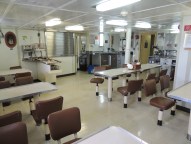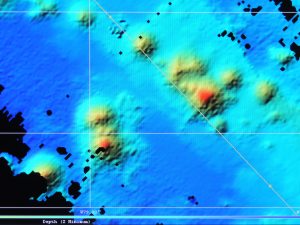NOAA Teacher at Sea
Sue Oltman
Aboard R/V Melville
May 22 – June 6, 2012
Mission: STRATUS Mooring Maintenance
Geographical Area: Southeastern Pacific Ocean, off the coast of Chile and Ecuador
Date: May 24, 2012
Weather Data from the Bridge:
Air temperature: 18.3 C / 64.9 F
Humidity: 70.3%
Precipitation: 0
Barometric pressure: 1011 mB
Wind speed: 2.3 NNW
Sea temperature: 19.16 C
Personal Log
The weather has been terrific – clear, in the 60’s with a little wind, nice sailing with the current helping us along. We are in the trade winds region. The view from the bridge (Captain’s pilot house) is excellent. Everyone is terrific and very patient in showing us the ropes. There’s plenty of time to get to know people. I’m getting to practice my Spanish a bit with our 2 students from the University of Concepcion (Chile) and two more Spanish speakers, from Chile and Ecuador. The two others on watch with me are Seb Bigorre (WHOI) and Ursula Cifuentes, a grad student from Chile, so we speak some Spanish during the watches. Life on a ship is different, but some of the comforts of home are here, too. Thank goodness there is a laundry, otherwise I would have had to bring 3 weeks worth of clothes! The food has really been fantastic!


The dinner tonight is carne asada (fajitas) and you can smell it cooking. Bob and Mark, our cooks, have also served us white bean chili, salads, cheeseburger sliders, roasted chicken, fish, pork roast and vegetables, seasoned hash browns, bacon and eggs, all kinds of fresh fruit, not to mention the desserts like blueberry cobbler and cinnamon rolls.
With all this great food, I was thankful to find that the crew makes places on the ship to work out! Some do “laps” by walking the ship a few dozen times around. There is an exercise room with weights and bikes and more equipment can be found in other places around the ship.
Science and Technology Log
The Woods Hole UOP (Upper Ocean Processes group) and rest of the team is now in a rhythm of deploying probes and gathering data. Like super sleuths, we are tracking a cold, relatively fresh water mass which originates inValparaiso and moves northwest. This water mass lies under the warm, salty surface layer. At 50 meters depth, there is a clear distinction in the water masses since we began deploying the UCTDs. Just like a detective matches fingerprints, we have a “fingerprint” of the cold, fresh water. A seasonal thermocline has been identified! Nan Galbraith, a programmer from WHOI, is processing all of the numerical data into useful images. The surface water layer (graph) has a temperature about 20º C and salinity > 35 ppt (parts per thousand). At 50 meters depth, the temperature abruptly drops to 17º C and falls to 7.5º C at 400 m which is the bottom depth we are testing; similarly the salinity drops to 34.1 ppt. Although we are traveling through water about 4,000 m deep, we are interested in tracking this water mass. I’m still having trouble remembering approximate Celsius to Fahrenheit conversions: here’s a link to help.
http://www.wbuf.noaa.gov/tempfc.htm
However, another factor has come into play which we must consider. We are nearing a tectonically active area – the Nazca Ridge, a fracture zone. There are many seamounts, some of which have not been previously mapped. Whoever is on watch must look at the ever-changing multi-beam sonar display to look for seamounts – we don’t want the instrument to slam into an underwater volcanic mountain! The closer we get to the Nazca Ridge, the higher the likelihood of seamounts.

All in all, we will cover about 2,268 miles until we reach the Galapagos, so the multibeam sonar is a critical piece of navigation equipment.
On the watches, as we deploy the UCTD probe, which looks like a 2 foot long bullet, weighing about 10 lbs., and good teamwork is the hallmark of a successful launch and recovery. Sometimes we are working in the dark with only the ship’s lights and a flashlight. I have learned how to make a splice in the line – the cord is only about 1 mm in diameter! This line and any splice must be strong enough to hold onto a 10 pound instrument being dragged though 400 m of water at 12 knots. Picture 3 people at 4 a.m. on a moving ship, using tiny instruments to sew a splice in a 1mm line, all while the line is attached to the winch. Like a surgical team, we are all focused and know what tool the splicer needs next. Sometimes quick thinking and a problem solving mindset is needed. There was a foam “bumper” that we had been attaching to the line to cover the probe when it got close to the boat. The probe is expensive and this was protection from it slamming into the steel fantail. When it was lost in the water, the team on watch used a nearby mop to protect the probe while reeling it in. On the next watch, Seb figured out a different solution.
Why does it smell like diapers in here?
Back in the lab a different bit of problem solving with the scientific method is going on! Often when buoys are recovered, they are fouled — covered with barnacles and all kinds of organisms, fishing line, etc. that get caught in them. Jeff Lord – mechanical whiz – has hypothesized that applying a better “anti-fouling” substance can keep these from affixing themselves to the equipment. He has liberally applied Desitin, a zinc oxide ointment, to the instruments. This is the same treatment for diaper rash on babies’ bottoms! So therefore, the odor in the lab reminds us of diapers. It will be a year before we know if Jeff’s hypothesis is correct, because after the STRATUS 12 buoy is moored, it will be a year before it is recovered. What do you think will happen?
Some of the science party was given a tour of the ships technical equipment behind the scenes. Bud Hale explained not only all of the monitors and ship terminology, but took us down into the equipment rooms where we encountered a gravimeter (measures gravity variations), modern gyros with optics and GPS (measures pitch, roll and heave).

Tomorrow, we hope to see the desalination plant on the ship which gives us our fresh drinking water.













